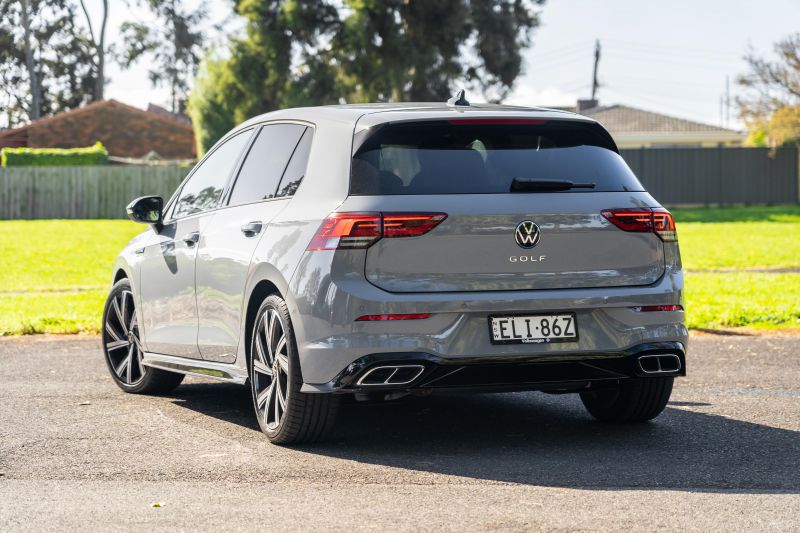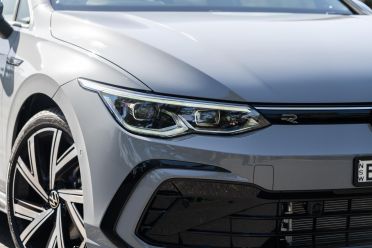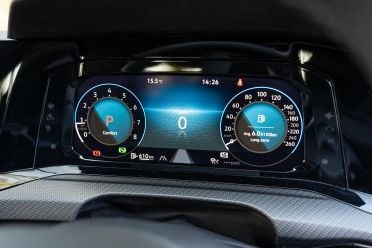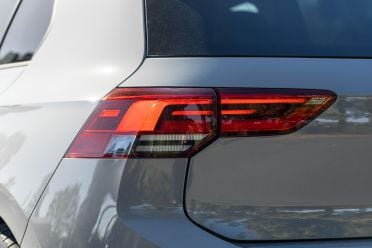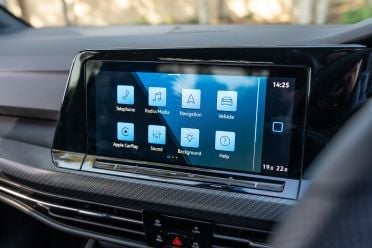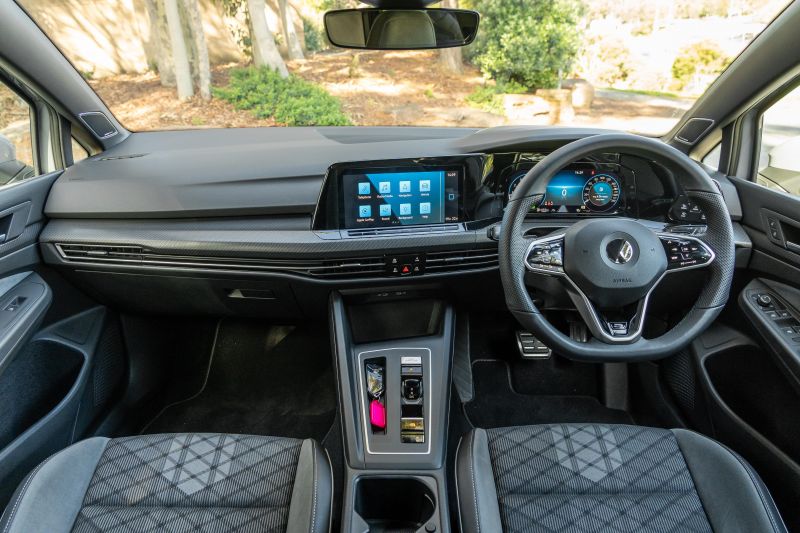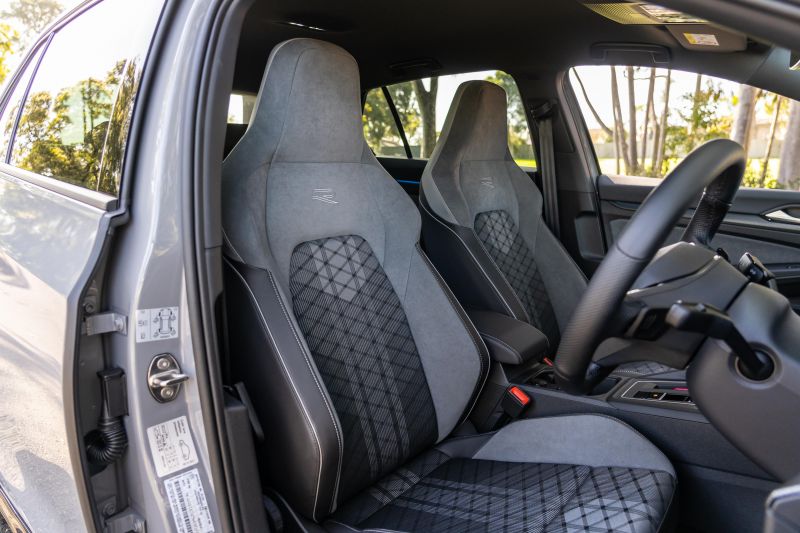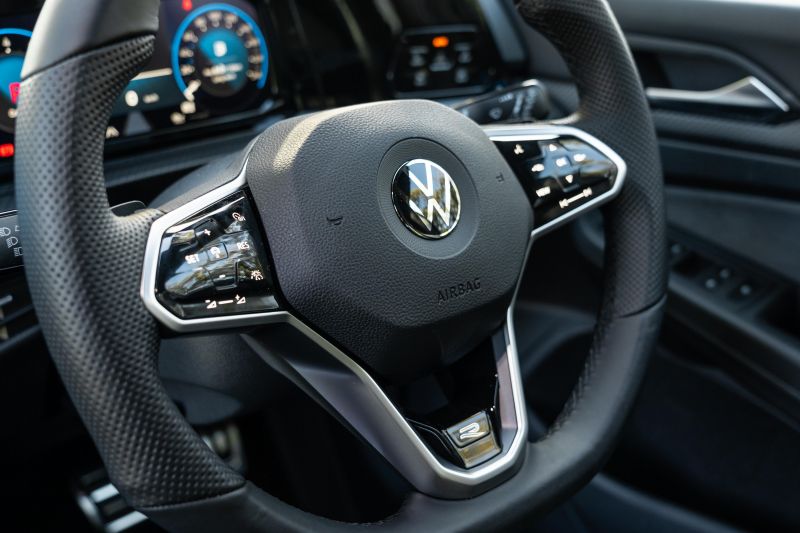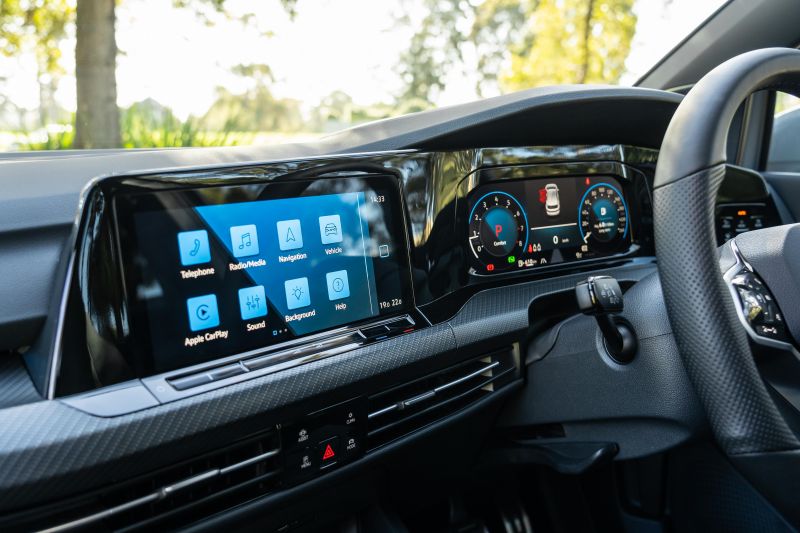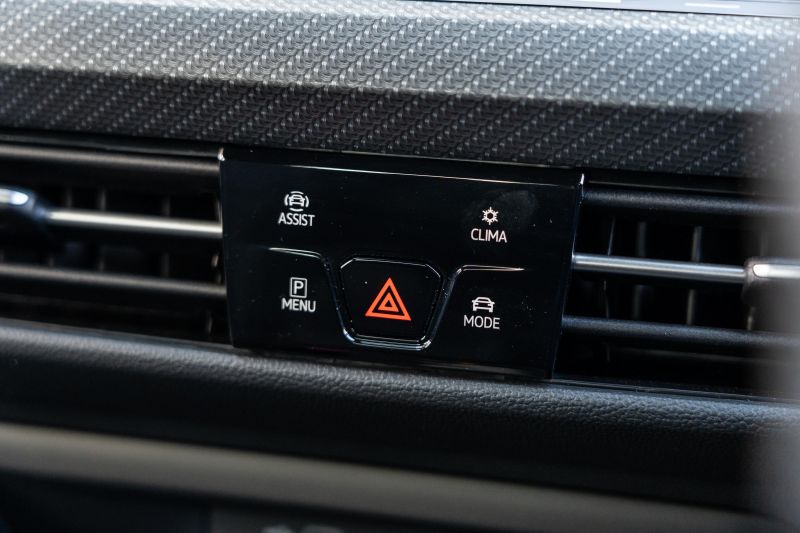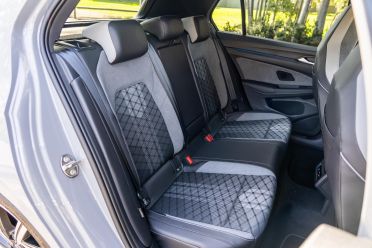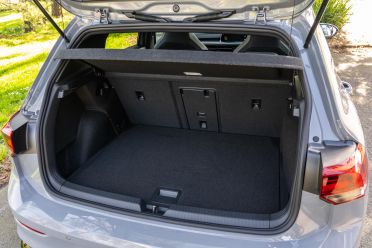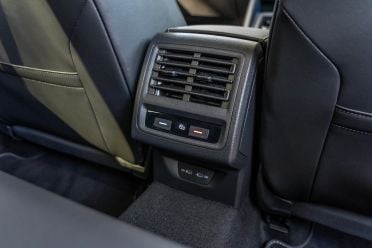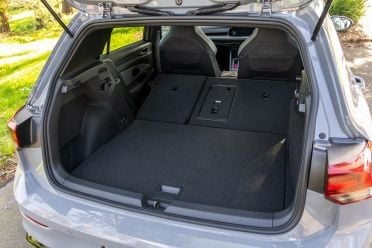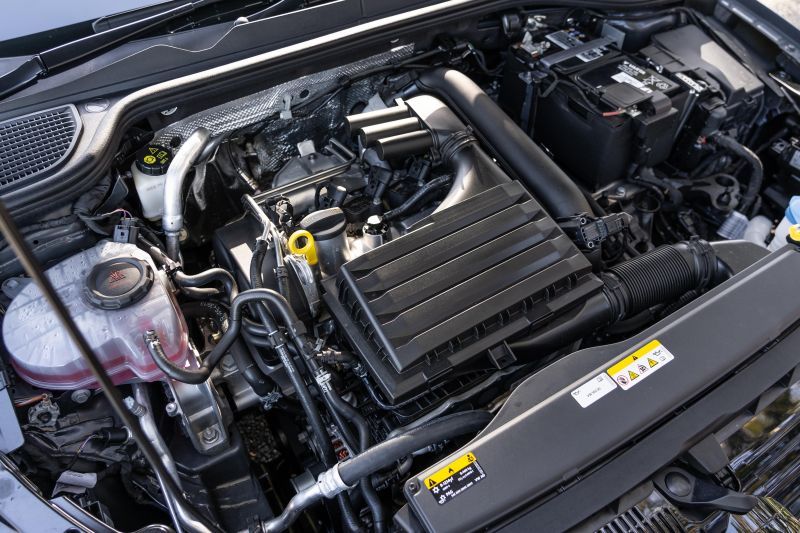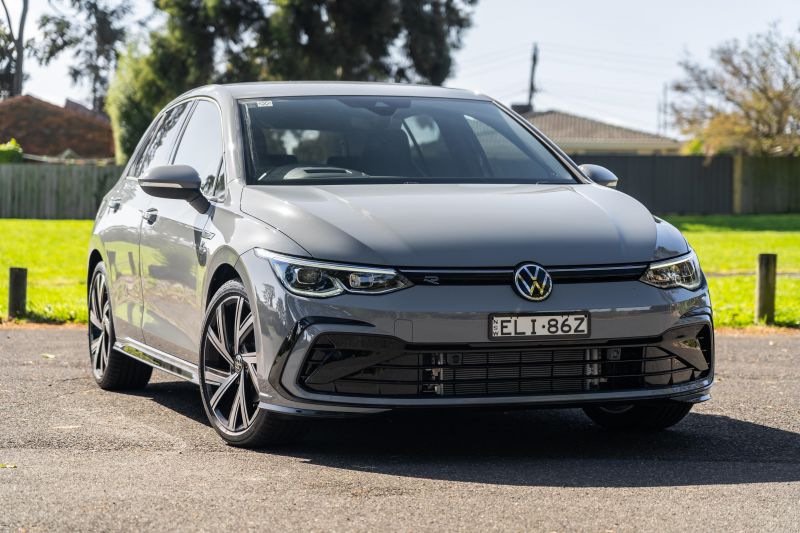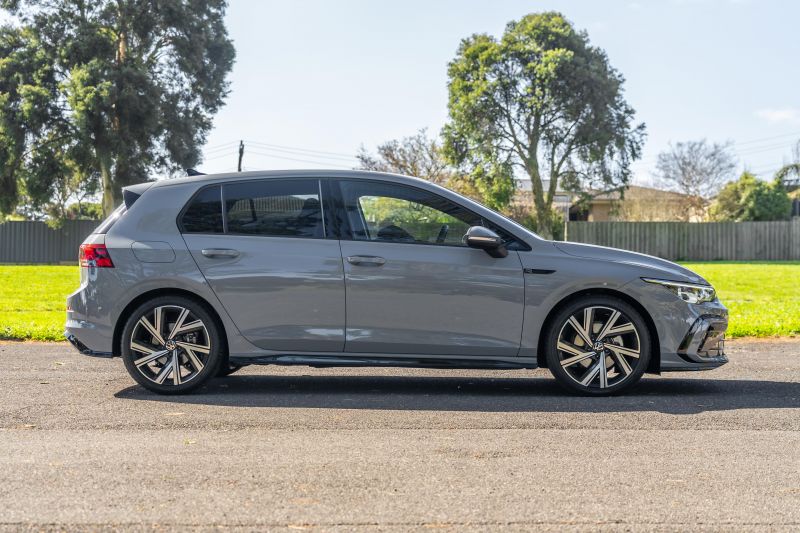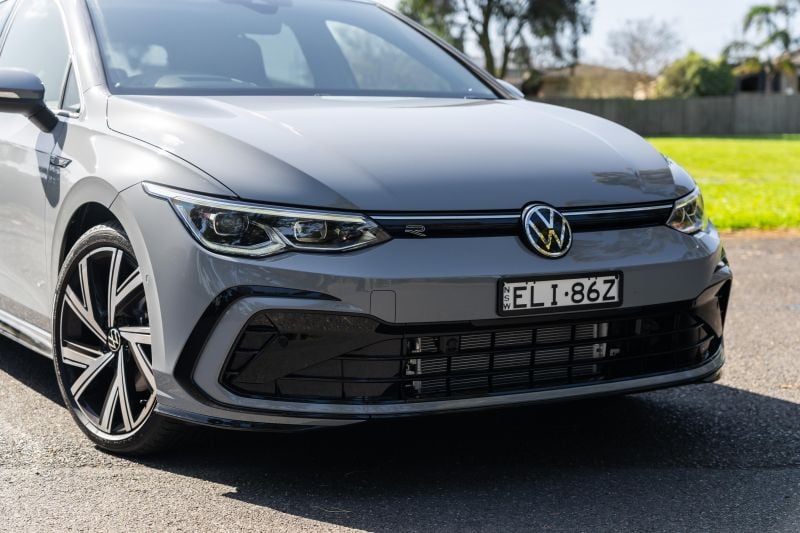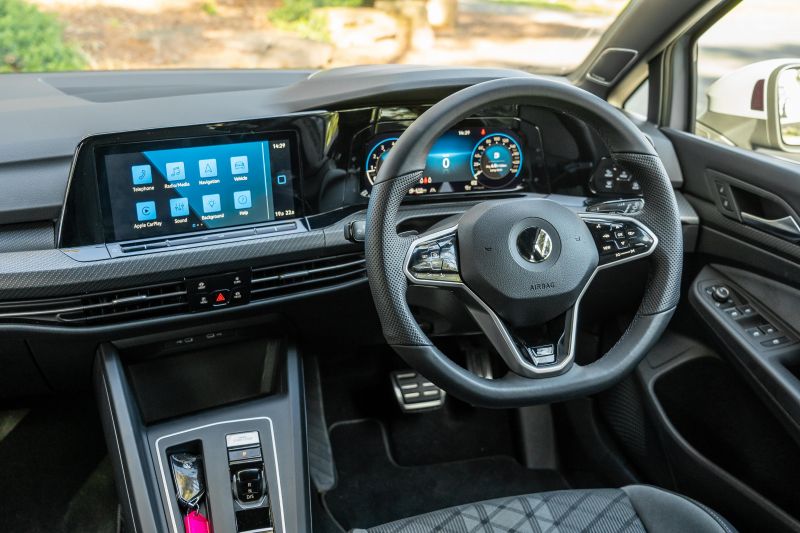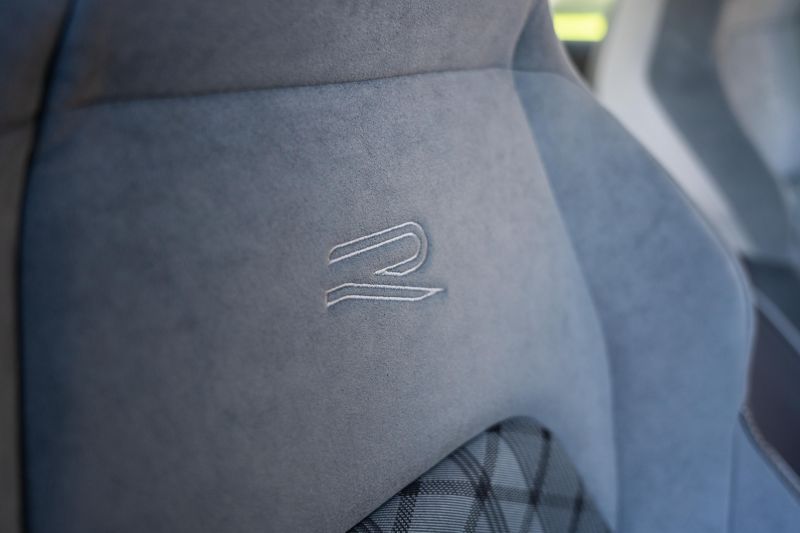The Volkswagen Golf is an institution in the hatchback world.
Now into its eighth generation, it’s the mark against which European, Korean, and Japanese rivals are judged. The R-Line badge doesn’t have quite the same provenance.
Introduced as an option package on the seventh-generation Golf Highline model, the R-Line offers something sporty to buyers who love the look of the Golf R, but not the price.
Figures from Volkswagen show 50 per cent more people bought a range-topping Golf Highline with the R-Line Package than bought a mid-range Comfortline late in the seventh-generation car’s life.
Supply has held the new R-Line back in Australia so far, but it’s hard to see its popularity waning.
Like its predecessor, it packs more presence than the regular Golf range, with a racier look and lower ride.
It’s not a carbon copy, though. The cabin of the eight-generation Golf has been shorn of its buttons, and the snappy dual-clutch transmission has turned into a torque converter.
The Golf R-Line is also faced with stronger-than-ever competition from Korea.
Should Volkswagen be worried?
How much does the Volkswagen Golf 110TSI R-Line cost?
The Golf 110TSI R-Line is priced from $37,450 before on-road costs, making it the most expensive model in the mainstream range.
It undercuts the proper GTI performance model and will be cheaper than the R.
The 2021 Golf range kicks off at $29,350 before on-road costs for the entry-level manual, and jumps to $31,950 if you opt for an automatic. Moving to the Golf 110TSI Life ups the price to $34,250 before on-roads.
The R-Line is right at the top end of the mainstream hatch world when it comes to pricing. The performance-oriented Hyundai i30 N Line Premium undercuts it at $36,220 before on-roads, as does the Kia Cerato GT at $36,990 drive-away.
Volkswagen would argue the Golf is more premium, Hyundai and Kia would argue the N Line and GT offer more punch at a better price.
What do you get?
Standard equipment in the base Volkswagen Golf includes:
- IQ. Drive highway driving assistant
- LED headlights
- Digital Cockpit (10.25-inch digital instruments)
- 8.25-inch infotainment screen with wireless Apple CarPlay and Android Auto
- Cloth upholstery
- Keyless start
- Automatic headlights
- Tri-zone climate control
- Leather-wrapped steering wheel
- Paddle shifters
- Rain-sensing wipers
- 16-inch alloy wheels
Moving to the Volkswagen Golf Life brings:
- Digital Cockpit Pro (configurable digital instruments)
- 10-inch infotainment system with wireless Apple CarPlay and Android Auto
- Wireless phone charging
- 10-colour ambient lighting
- Keyless entry
- Factory satellite navigation
- Microfleece cloth seating with brushed inlays
- Front seat lumbar adjustment
- Rear centre seat armrest
- 17-inch alloy wheels
Jumping to the Volkswagen Golf R-Line we have on test here adds:
- Sport seats with leather trim
- 18-inch alloy wheels
- Lowered (15mm) R-Line suspension
- R-Line exterior trim
- 30-colour ambient lighting
Metallic paint is a $300 option on the R-Line, premium metallic paint is $900.
The Sound and Vision package (fitted) to our tester is an additional $1500, and brings a head-up display and a 480W Harman/Kardon sound system.
Is the Volkswagen Golf 110TSI R-Line safe?
The 2021 Volkswagen Golf has a five-star ANCAP safety rating based on testing carried out by Euro NCAP in 2019.
It scored 95 per cent for adult occupant protection, 89 per cent for child occupant protection, 76 per cent for vulnerable road user protection, and 80 per cent for safety assist.
Standard safety equipment in Australia includes:
- AEB with pedestrian/cyclist detection
- Multi-collision brake
- Lane-keep assist
- Front cross-traffic assist
- Rear cross-traffic alert
- Blind-spot monitoring
- Parking sensors
- Reversing camera
Opting for the Life or R-Line brings Emergency Assist and Volkswagen’s exit warning system. All models feature eight airbags as standard.
What is the Volkswagen Golf 110TSI R-Line like on the inside?
Someone at Volkswagen has a nasty vendetta against buttons.
The seventh-generation Golf was a gentle evolution of the sixth-generation car, itself an evolution of the mould-breaking fifth-generation model. The Mk8 you seen here represents the start of something new.
Buttons are few and far between, and two big screens with beautifully-rendered, colourful graphics are standard across the range.
The interior looks seriously slick, and a lot of the stuff that was good about the last Golf carries over.
The driving position is a strong point. The driver’s seat drops down low and slides back far enough to accomodate long-legged pilots, the steering wheel feels great in the hands, and vision out the heavily-reclined windscreen is good.
At more than $45,000 drive-away though, it’s a bit disappointing the sports seats aren’t heated, ventilated, or power-adjustable.
I’d read reports of hard, scratchy plastics and noticeable cost-cutting in the new Golf, but the R-Line is up to the standard you’d expect of a high-end mainstream hatch.
The front doors are topped with soft-touch trim, the dash has a matte finish, and the tiny gear selector clicks positively into place.
In a some ways, you could convince people this is an Audi interior rather than a Volkswagen one. It looks brilliant.
There are some hard plastics hidden down low though, and the rear doors haven’t been treated to the same soft-touch tops as the fronts.
Some Golf staples are noticeably absent, too. The door bins are still felt-lined to stop things rattling around, but there’s no fold-down storage drawer to the right-hand side of the steering wheel.
The cupholders aren’t hidden under a sliding lid, and the 12V plug is now covered by a cheap-feeling cover.
Sure, they’re small things, but they’re the small things that have always helped the Golf feel a cut above the rest. In some ways, Volkswagen is a victim of its own high standards.
Cost-cutting is a part of motoring life, especially at this end of the market, but the new Golf is far from cheap and has a carryover engine, so some of the cuts feel a bit cruel.
As for the technology? It’s a mixed bag.
The driver’s display is excellent, with crisp graphics and just the right amount of information, but in eliminating buttons Volkswagen has also steepened the learning curve involved in even the simplest tasks.
You need to press a gloss black touch button on the dash and fiddle with the touchscreen just to change the fan speed, for example, which means you lose your navigation or media display.
It means more time with your eyes off the road, and more fingerprints on the screen and its gloss black surround, even if what you want to do should be simple.
Familiarity helps, but there’s no getting around the fact things that used to be easy are now harder. That’s not good enough in what’s meant to be an evolved take on the formula.
At least the graphics are super clean, the responses sharp, and the customisation options nearly endless. The bones of a good system are there, but they’re hidden beneath a frustrating layer of user unfriendliness.
Rear seat passengers are treated to decent legroom and headroom, with space for average-sized adults behind average-sized adults. Not only are there vents, the climate control pod allows rear passengers to set their own temperature.
There’s also a fold-down armrest back there. Visibility is decent for short passengers, despite a high-ish windowline, although the one-piece backrest on the R-Line seats does make it hard to see out the front of the car.
The outboard seats have ISOFIX points, and there are three top-tether points for child seats. The rear seats fold 60/40 (although there’s a central ski port).
Boot space is 381L with the rear seats in place, and 1230L with them folded. The space itself is broad and practical, and there’s no major loading lip when you pop the boot using the Volkswagen badge.
What’s under the bonnet?
The mainstream Golf range will be powered by a 1.4-litre turbocharged four-cylinder petrol engine in Australia, making 110kW of power and 250Nm of torque.
It’s front-wheel drive and has an eight-speed torque converter automatic or a six-speed manual transmission.
Those outputs probably look familiar to previous-generation Golf owners. They should; they’re the same.
Why? The 2021 Golf is powered by the same engine as before, albeit hooked up to a torque converter transmission instead of the dual-clutch we used to get.
Volkswagen says the 1.5-litre engine and dual-clutch the Golf gets in Europe is being reserved for markets where its superior economy helps it undercut strict fleet emissions targets.
The Golf offered in Australia drinks a claimed 5.8L/100km on the combined cycle. We saw 5.6L/100km in a week with the car, with a skew to highway driving and no traffic thanks to COVID-19.
How does the Volkswagen Golf 110TSI R-Line drive?
For all that’s changed, the Mk 8 Golf still feels like a Golf.
It’s smooth and quiet, with a planted feeling that wouldn’t be out of place in a bigger, more expensive car.
The switch from a dual-clutch transmission to a more conventional torque converter means the new Golf uses more fuel than its predecessor, but it also makes it smoother and easier to drive in the city.
Even the best dual-clutch transmissions carry some kind of learning curve, the eight-speeder in the new Golf doesn’t.
It’s smart enough to keep the 1.4-litre engine in its torque band most of the time, slurring inoffensively from gear-to-gear when you’re cruising.
As has always been the case, the turbocharged four-cylinder engine in the Golf is an effortless companion. Its outputs are down on what you get in the latest warm hatches from Hyundai and Kia, but its buttery smooth power delivery and torquey mid-range mean you never need to work it hard.
Where it does feel like a backwards step is when you’re in a hurry. Even in Sport mode the eight-speed Golf doesn’t snap through the ratios with the confidence of a DSG, and taking charge with the paddles isn’t as satisfying.
Is that likely to worry the average owner? Probably not, although it’s arguably more of an issue in the sporty Golf R-Line than in its more demure siblings.
The coat of polish applied to the engine extends to the ride and handling, too. The R-Line sits 15mm lower than the regular Golf, but it soaks up the worst the city can throw at it without breaking a sweat.
It’s a bit firmer than the related Skoda Octavia, but it’s still perfectly usable day-to-day.
In traditional Volkswagen fashion, body control is tight without feeling outright sporty. It deals with speed bumps in one movement, the body settling quickly.
Unlike some of its rivals, Volkswagen has stuck with a multi-link rear suspension on the Golf. That has a negative impact on boot space, but it also contributes to the car’s planted, neutral feeling from behind the wheel.
Flick it into a corner and the nose just goes where you want it to, with very little in the way of understeer or lairy, lift-off oversteer.
Even in R-Line guise the Golf majors on low-fuss stability rather than outright thrills, although it’ll put a smile on your face if you’re willing to take it by the scruff of the neck.
It’s not perfect, though. The tyres are noisy on the highway, especially Australian coarse-chip highways, and Volkswagen’s adaptive cruise control won’t pass to the left of a slower car.
In Europe, where lane discipline is drummed into drivers from day one, that’s a good thing. In Australia, where it’s common for drivers to sit in the right lane doing 10km/h below the limit, it’s annoying.
How much does the Volkswagen Golf 110TSI R-Line cost to run?
The Golf is backed by a five-year, unlimited-kilometre warranty.
Maintenance is required every 12 months or 15,000km and Volkswagen offers three- and five-year prepaid service packages for $1100 or $1900 respectively.
The Golf GTI is more expensive to service; a three-year plan costs $1450 and a five-year plan will set you back $2300.
CarExpert’s Take on the Volkswagen Golf 110TSI R-Line
In some ways, the Golf R-Line moves the game forward from its already excellent predecessor.
Even without its snappy dual-clutch transmission, the Golf is the most polished small car you can buy without forking out for something with a more premium badge on its nose.
If you’ve driven and loved a Golf in the past, you’ll probably love this one.
All the oily bits are polished, but in some ways the Mk8 isn’t as resolved as its predecessors.
One of the reasons the Golf is a small-car staple is because it’s traditionally felt like all the rough edges have been smoothed away, but the technology in the Mk8 feels a bit first-generation.
Thankfully, software can be updated over time. For all that’s good about it, this Golf still needs a bit of refining.
Is the R-Line the pick of the range? At $3200 more than the Life, you could argue the sharper looks and interior are worth it, but the drive is still quietly competent rather than outright racy.
I’d be saving the extra money and sticking with the Life… or pinching pennies until the full-on Golf R arrives in 2022.
Click the images for the full gallery

